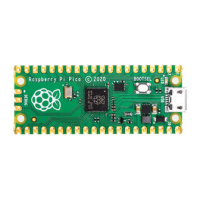The destination for stdout can be changed using CMake directives, with output directed to UART or USB CDC, or to both,
pico_enable_stdio_usb(hello_world 1) ①
pico_enable_stdio_uart(hello_world 0) ②
1.
Enable
printf output via USB CDC (USB serial)
2.
Disable
printf output via UART
This means that without changing the C source code, you can change the destination for
stdio from UART to USB.
Pico Examples: https://github.com/raspberrypi/pico-examples/tree/master/hello_world/usb/CMakeLists.txt Lines 1 - 20
Ê1 if (TARGET tinyusb_device)
Ê2 add_executable(hello_usb
Ê3 hello_usb.c
Ê4 )
Ê5
Ê6 # Pull in our pico_stdlib which aggregates commonly used features
Ê7 target_link_libraries(hello_usb pico_stdlib)
Ê8
Ê9 # enable usb output, disable uart output
10 pico_enable_stdio_usb(hello_usb 1)
11 pico_enable_stdio_uart(hello_usb 0)
12
13 # create map/bin/hex/uf2 file etc.
14 pico_add_extra_outputs(hello_usb)
15
16 # add url via pico_set_program_url
17 example_auto_set_url(hello_usb)
18 elseif(PICO_ON_DEVICE)
19 message(WARNING "not building hello_usb because TinyUSB submodule is not initialized in
Ê the SDK")
20 endif()
4.2. Build "Hello World"
As we did for the previous "Blink" example, change directory into the
hello_world directory inside the pico-examples/build
tree, and run make.
$ cd hello_world
$ make -j4
Scanning dependencies of target ELF2UF2Build
[ 0%] Creating directories for 'ELF2UF2Build'
Ê .
Ê .
[ 33%] Linking CXX executable hello_usb.elf
[ 33%] Built target hello_usb
Ê .
Ê .
[100%] Linking CXX executable hello_serial.elf
[100%] Built target hello_serial
This will build two separate examples programs in the
hello_world/serial/ and hello_world/usb/ directories.
Getting started with Raspberry Pi Pico
4.2. Build "Hello World" 13

